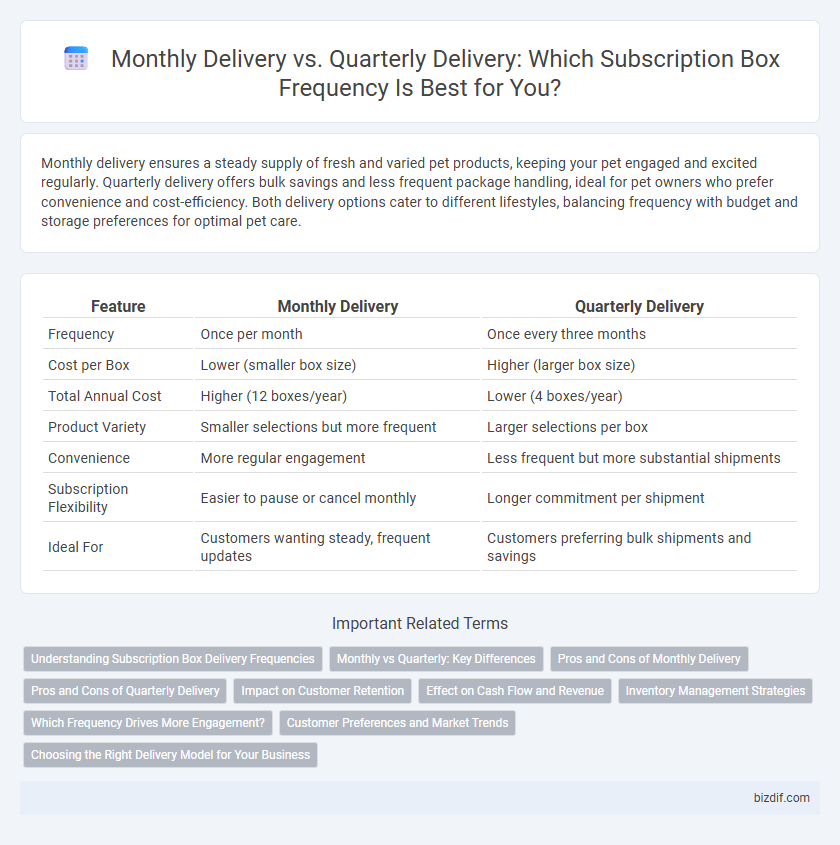Monthly delivery ensures a steady supply of fresh and varied pet products, keeping your pet engaged and excited regularly. Quarterly delivery offers bulk savings and less frequent package handling, ideal for pet owners who prefer convenience and cost-efficiency. Both delivery options cater to different lifestyles, balancing frequency with budget and storage preferences for optimal pet care.
Table of Comparison
| Feature | Monthly Delivery | Quarterly Delivery |
|---|---|---|
| Frequency | Once per month | Once every three months |
| Cost per Box | Lower (smaller box size) | Higher (larger box size) |
| Total Annual Cost | Higher (12 boxes/year) | Lower (4 boxes/year) |
| Product Variety | Smaller selections but more frequent | Larger selections per box |
| Convenience | More regular engagement | Less frequent but more substantial shipments |
| Subscription Flexibility | Easier to pause or cancel monthly | Longer commitment per shipment |
| Ideal For | Customers wanting steady, frequent updates | Customers preferring bulk shipments and savings |
Understanding Subscription Box Delivery Frequencies
Subscription box delivery frequencies typically vary between monthly and quarterly options to match customer preferences and consumption habits. Monthly delivery offers frequent product updates and a steady stream of curated items, ideal for those seeking consistent engagement or faster product discovery. Quarterly delivery reduces shipment frequency, appealing to customers who prefer less frequent but larger or more curated selections, balancing convenience with anticipation.
Monthly vs Quarterly: Key Differences
Monthly subscription boxes offer more frequent, smaller shipments, enabling customers to enjoy fresh, curated products regularly and maintain excitement each month. Quarterly delivery provides larger, more comprehensive boxes that focus on seasonal themes, offering greater value and carefully curated selections tailored to longer intervals. Choosing between monthly and quarterly depends on preferences for frequency, product volume, and budget flexibility in subscription box services.
Pros and Cons of Monthly Delivery
Monthly delivery subscription boxes offer the advantage of frequent product refreshment, keeping subscribers engaged and excited with new items every month. However, monthly shipments can lead to higher shipping costs and may overwhelm customers with too many products in a short time, resulting in potential product fatigue. Businesses benefit from consistent cash flow and regular customer touchpoints but must manage inventory and logistics more intensively compared to quarterly deliveries.
Pros and Cons of Quarterly Delivery
Quarterly delivery subscription boxes offer the advantage of less frequent shipments, reducing packaging waste and allowing customers to enjoy products at a more relaxed pace. This schedule can also lower shipping costs and provide time to fully appreciate each box's contents before receiving the next one. However, quarterly delivery may lead to longer waits for new items, potentially impacting customer excitement and timely use of perishable or seasonal products.
Impact on Customer Retention
Monthly delivery schedules enhance customer retention by maintaining consistent engagement and reinforcing brand loyalty more frequently. Quarterly delivery may reduce perceived value due to longer wait times, potentially decreasing regular interaction and weakening brand recall. Frequent deliveries offer continuous satisfaction signals, which directly contribute to stronger long-term subscription commitments.
Effect on Cash Flow and Revenue
Monthly subscription box deliveries generate consistent cash flow and steady revenue streams by encouraging frequent customer engagement and recurring payments. Quarterly delivery models may lead to larger, less frequent revenue spikes but can cause irregular cash inflows, impacting short-term liquidity and operational budgeting. Businesses must balance customer retention tactics with cash flow management to optimize financial stability and growth.
Inventory Management Strategies
Monthly delivery schedules in subscription boxes require agile inventory management to maintain optimal stock levels and meet consistent consumer demand, minimizing storage costs and reducing the risk of overstock. Quarterly delivery cycles allow for bulk purchasing and consolidated inventory planning, optimizing supply chain efficiency but demanding accurate demand forecasting to prevent stockouts or excess inventory. Effective inventory management strategies balance supplier lead times, storage capacity, and customer preferences to streamline monthly or quarterly fulfillment processes.
Which Frequency Drives More Engagement?
Monthly delivery subscriptions generally drive higher engagement by maintaining consistent customer interaction and anticipation, leading to increased brand loyalty and quicker feedback loops. Quarterly delivery models may reduce purchase fatigue and appeal to customers preferring less frequent commitments, but often see lower touchpoints and slower response rates. Data from consumer behavior analytics shows that monthly shipments lead to a 20-30% increase in active user engagement compared to quarterly shipments.
Customer Preferences and Market Trends
Customer preferences in subscription box services are shifting towards monthly delivery due to the desire for consistent engagement and frequent product updates, which enhance user satisfaction and brand loyalty. Market trends indicate a growing demand for flexibility, with some consumers favoring quarterly delivery to reduce costs and avoid subscription fatigue. Data shows that companies offering both options experience higher retention rates by catering to diverse consumer needs and purchasing behaviors.
Choosing the Right Delivery Model for Your Business
Selecting the ideal subscription box delivery model hinges on customer preferences, cash flow, and product type, as monthly deliveries support steady engagement and faster feedback cycles while quarterly deliveries reduce shipping costs and inventory pressure. Businesses with perishable or trendy items benefit from monthly shipments to maintain freshness and relevance, whereas those offering durable or niche products may find quarterly schedules more cost-effective and manageable. Analyzing customer retention metrics and supply chain logistics helps tailor the delivery frequency to optimize satisfaction and operational efficiency.
Monthly delivery vs Quarterly delivery Infographic

 bizdif.com
bizdif.com